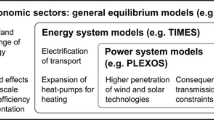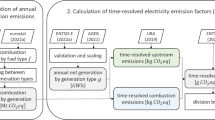Abstract
Purpose
Electricity production is one of the largest sources of environmental emissions—especially greenhouse gases (GHGs)—in the USA. Emission factors (EFs) vary from region to region, which requires the use of spatially relevant EF data for electricity production while performing life cycle assessments (LCAs). Uncertainty information, which is sought by LCA practitioners, is rarely supplied with available life cycle inventories (LCIs).
Methods
To address these challenges, we present a method for collecting data from different sources for electricity generation and environmental emissions; discuss the challenges involved in agglomerating such data; provide relevant suggestions and solutions to merge the information; and calculate EFs for electricity generation processes from various fuel sources for different spatial regions and spatial resolutions. The EFs from the US 2016 Electricity Life Cycle Inventory (eLCI) are analyzed and explored in this study. We also explore the method of uncertainty information derivation for the EFs.
Results and discussion
We explore the EFs from different technologies across Emissions & Generation Resource Integrated Database (eGRID) regions in the USA. We find that for certain eGRID regions, the same electricity production technology may have worse emissions. This may be a result of the age of the plants in the region, the quality of fuel used, or other underlying factors. Region-wise life cycle impact assessment (LCIA) ISO 14040 impacts for total generation mix activities provide an overview of the total sustainability profile of electricity production in a particular region, rather than only global warming potential (GWP). We also find that, for different LCIA impacts, several eGRID regions are consistently worse than the US average LCIA impact for every unit of electricity generated.
Conclusion
This work describes the development of an electricity production LCI at different spatial resolutions by combining and harmonizing information from several databases. The inventory consists of emissions, fuel inputs, and electricity and steam outputs from different electricity production technologies located across various regions of the USA. This LCI for electricity production in the USA will prove to be an enormous resource for all LCA researchers—considering the detailed sources of the information and the breadth of emissions covered by it.











Similar content being viewed by others
Data availability
The datasets generated and/or analyzed during this study are available in the electricity baseline life cycle inventory repository. Source code is available on a GitHub repository.
https://www.lcacommons.gov/lca-collaboration/Federal_LCA_Commons/US_electricity_baseline/datasets
Change history
31 March 2023
A Correction to this paper has been published: https://doi.org/10.1007/s11367-023-02138-0
References
Argonne National Laboratory (2019) GREET vehicle-cycle model. Argonne National Laboratory: Argonne, IL, United States. Available at: https://greet.es.anl.gov. Accessed 1 Nov 2020
CARB (2016) California greenhouse gas emission inventory program | California Air Resources Board. https://ww2.arb.ca.gov/our-work/programs/ghg-inventory-program. Accessed 10 Apr 2022
Cashman SA, Meyer DE, Edelen AN, Ingwersen WW, Abraham JP, Barrett WM, Gonzalez MA, Randall PM, Ruiz-Mercado G, Smith RL (2016) Mining available data from the United States Environmental Protection Agency to support rapid life cycle inventory modeling of chemical manufacturing. Environ Sci Technol 50(17):9013–9025. https://doi.org/10.1021/acs.est.6b02160
de Chalendar JA, Taggart J, Benson SM (2019) Tracking emissions in the US electricity system. Proc Natl Acad Sci 116(51):25497–25502. https://doi.org/10.1073/pnas.1912950116
Department of Environmental Quality (2019) Oregon greenhouse gas sector-based inventory data : air quality programs : State of Oregon. https://www.oregon.gov/deq/aq/programs/Pages/GHG-Inventory.aspx. Accessed 10 Apr 2022
DVRPC (2018) Delaware valley regional planning commission regional greenhouse gas emissions inventory. https://www.dvrpc.org/energyclimate/inventory/. Accessed 10 Apr 2022
EIA (2015) Form EIA-923 (EIA-906/920). https://www.eia.gov/electricity/data/eia923/. Accessed 11 Nov 2022
Gagnon P, Frazier W, Cole W, Hale E (2021) Cambium documentation: Version 2021; NREL/TP-6A40–81611; National Renewable Energy Lab. (NREL), Golden, CO (United States). https://doi.org/10.2172/1835075
Gately C, Hutrya LR (2018) CMS: CO2 emissions from fossil fuels combustion, ACES Inventory for Northeastern USA. 43202.655434 MB. https://doi.org/10.3334/ORNLDAAC/1501
Hottle T, Ghosh T (2021) Regional Electricity Consumption Mixes Using Trade Data for Representative Inventories. Int J Life Cycle Assess 26(6):1211–1222. https://doi.org/10.1007/s11367-021-01876-3
Hutchins MG, Colby JD, Marland G, Marland E (2017) A Comparison of Five High-Resolution Spatially-Explicit, Fossil-Fuel, Carbon Dioxide Emission Inventories for the United States. Mitig Adapt Strateg Glob Change 22(6):947–972. https://doi.org/10.1007/s11027-016-9709-9
International Energy Agency (2016). https://www.iea.org/data-and-statistics/data-products. Accessed 10 Apr 2022
Ingwersen W, Bergmann M, Liadov M, Ghosh T, Li M, Cashman SA (2019) Standardized emission and waste inventories (StEWI), v0.9.1
Jaramillo P, Muller NZ (2016) Air pollution emissions and damages from energy production in the U.S.: 2002–2011. Energy Policy 90, 202–211. https://doi.org/10.1016/j.enpol.2015.12.035
Koffler C, Hengstler J, Thellier L, Stoffregen A (2019) On the relevance of scope 3 emissions and power trade for regional life cycle inventories of electricity consumption in the USA. Int J Life Cycle Assess 24(8):1360–1375. https://doi.org/10.1007/s11367-018-1566-1
Mutel CL, Pfister S, Hellweg S (2012) GIS-Based Regionalized Life Cycle Assessment: How Big Is Small Enough? Methodology and Case Study of Electricity Generation. Environ Sci Technol 46(2):1096–1103. https://doi.org/10.1021/es203117z
NREL (2022) U.S. Life Cycle Inventory Database. https://www.nrel.gov/lci/index.html. Accessed 10 Apr 2022
Sengupta D, Hawkins TR, Smith RL (2015) Using national inventories for estimating environmental impacts of products from industrial sectors: a case study of ethanol and gasoline. Int J Life Cycle Assess 20(5):597–607. https://doi.org/10.1007/s11367-015-0859-x
Tamayao M-AM, Michalek JJ, Hendrickson C, Azevedo IML (2015) Regional variability and uncertainty of electric vehicle life cycle CO2 emissions across the United States. Environ Sci Technol 49(14):8844–8855. https://doi.org/10.1021/acs.est.5b00815
Tiseo I (2021) U.S. electric utilities SO2 emissions 1970–2020. Statista. https://www.statista.com/statistics/504390/volume-of-sulfur-dioxide-emissions-from-fuel-combustion-in-electric-utilities-us/. Accessed 29 Apr 2022
US EPA (2015a) Environmental Protection Agency- National Emissions Inventory (NEI). https://www.epa.gov/air-emissions-inventories/national-emissions-inventory-nei. Accessed 11 Nov 2021
US EPA (2015b) Environmental Protection Agency- RCRAInfo Overview. https://www.epa.gov/enviro/rcrainfo-overview. Accessed 11 Nov 2021
US EPA (2016) Environmental Protection Agency- Toxics Release Inventory (TRI) Program. https://www.epa.gov/toxics-release-inventory-tri-program. Accessed 11 Nov 2021
US EPA(2018a) Environmental Protection Agency- Our Nation’s Air. https://gispub.epa.gov/air/trendsreport/2018/#naaqs. Accessed 11 Nov 2021
US EPA (2018b) Environmental Protection Agency- Facility Registry Service (FRS). https://www.epa.gov/frs. Accessed 12 Nov 2021
US EPA (2020) Environmental Protection Agency- Emissions & generation resource integrated database (eGRID). https://www.epa.gov/egrid. Accessed 11 Nov 2021
US EPA (2022) Environmental Protection Agency- Federal_LCA_Commons/US_electricity_baseline | LCA Collaboration Server. https://www.lcacommons.gov/lca-collaboration/Federal_LCA_Commons/US_electricity_baseline/datasets. Accessed 28 Apr 2022
Yang Y, Ingwersen WW, Hawkins TR, Srocka M, Meyer DE (2017) USEEIO: A New and Transparent United States Environmentally-Extended Input-Output Model. J of Clean Prod 158:308–318. https://doi.org/10.1016/j.jclepro.2017.04.150
Young B, Ingwersen WW, Bergmann M, Hernandez-Betancur JD, Ghosh T, Bell E, Cashman SA (2022) System for Standardizing and Combining U.S. Environmental Protection Agency Emissions and Waste Inventory Data. Appl Sci 12 (7), 3447. https://doi.org/10.3390/app12073447
Acknowledgements
The authors wish to thank Emily Newes and Dan Bilello for their feedback on this manuscript. This research was conducted as part of the EPA Air, Climate, and Energy National Research Program. Support was provided by the National Renewable Energy Laboratory through Interagency Agreement DW-89-92448301-1, and by Eastern Research Group (ERG) through EPA contract EP-C-16-015, Task Order 008. We acknowledge the valuable contributions of Timothy Skone, Gregory Cooney, George Zaimes, and Ambica Pegallapati at the National Energy Technology Laboratory and KeyLogic.
Funding
Funding was provided by the US EPA Office of Research and Development’s Chemical Safety and Sustainability National Research Program and the former National Risk Management Research Laboratory. The US Environmental Protection Agency, through its Office of Research and Development, funded and conducted the research described herein under an approved Quality Assurance Project Plan.
Author information
Authors and Affiliations
Contributions
Conceptualization, W. W. I.; software, W. W. I., T. G. M. J., T. H.; data curation, W. W. I, T. G., M. J., T. H, K. R.; investigation, W.W.I, T.G. M.J., T.H.; methodology, W.W.I, T.G. M.J., T.H.; validation, W.W.I, T.G., M. J., T. H., A. C., T. R. H., S. C., A. C.; visualization, W. W. I, T. G.; writing, W. W. I, T. G., M. J.,T. R. H., S. C.
Corresponding author
Ethics declarations
Conflict of interest
The authors declare no competing interests.
Disclaimer
The work has been subjected to review by the EPA Office of Research and Development and approved for publication. Approval does not signify that the contents reflect the views of the Agency, nor does mention of trade names or commercial products constitute endorsement or recommendation for use.
Additional information
Communicated by Martin Baitz
Publisher's Note
Springer Nature remains neutral with regard to jurisdictional claims in published maps and institutional affiliations.
The original online version of this article was revised: affiliation number 5 was incorrectly assigned to the author Sarah Cashman. The correct affiliation is "Eastern Research Group, Inc, Concord, MA, USA". Furthermore, the wrong supplementary file was originally published.
Supplementary Information
Below is the link to the electronic supplementary material.
Rights and permissions
About this article
Cite this article
Ghosh, T., Ingwersen, W.W., Jamieson, M. et al. Derivation and assessment of regional electricity generation emission factors in the USA. Int J Life Cycle Assess 28, 156–171 (2023). https://doi.org/10.1007/s11367-022-02113-1
Received:
Accepted:
Published:
Issue Date:
DOI: https://doi.org/10.1007/s11367-022-02113-1




